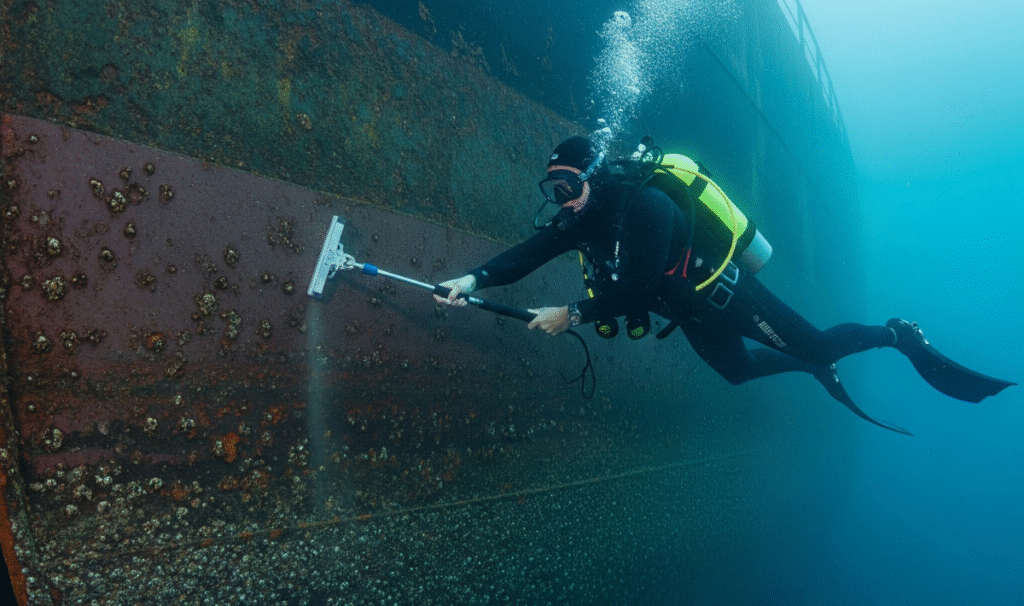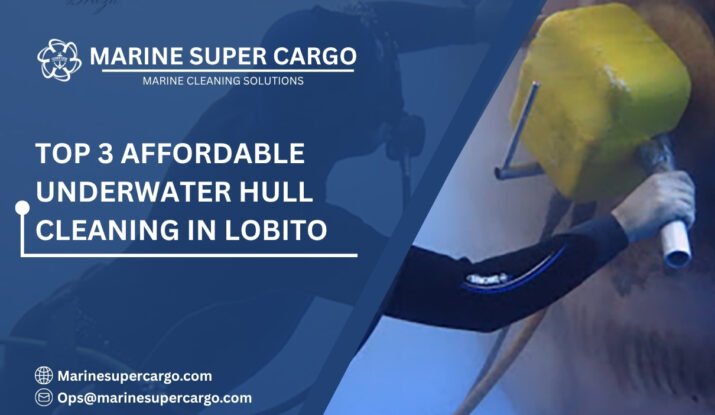If you’ve ever tried running through water while wearing heavy boots, you’ll know how much harder it feels compared to running freely. The same principle applies to ships. When the underwater hull is covered with marine growth, it feels like dragging a burden with every mile traveled. That’s why underwater hull cleaning in Lobito has become an indispensable part of ship maintenance.
As one of Angola’s busiest ports on the Atlantic coast, Lobito sees a steady flow of cargo vessels, fishing fleets, and tankers. With this traffic comes a growing awareness of hull efficiency, regulatory compliance, and environmental protection. In today’s maritime industry, these are not just technical issues—they’re profit drivers and sustainability essentials.
This guide explores why hull cleaning matters in Lobito, how it works, compliance requirements, the environmental and financial benefits, and the innovations shaping the future. Whether you’re a ship owner, operator, or manager, you’ll find insights here to keep your fleet efficient, compliant, and profitable.
Why Hull Cleaning in Lobito Matters
The Port of Lobito is a major maritime gateway for regional trade across West and Central Africa. However, its warm Atlantic waters are ideal grounds for marine fouling. Algae, barnacles, mussels, and other organisms quickly attach themselves to a vessel’s hull, causing drag.
That drag forces ships to burn significantly more fuel—sometimes 20–30% more. By scheduling underwater hull cleaning in Lobito, operators improve performance, conserve fuel, and reduce harmful emissions. It’s much like keeping your car tires properly inflated—you’ll get more mileage and spend less per trip.
The Problem of Hull Fouling
Marine fouling is one of the silent threats to maritime efficiency. It’s not always visible since it hides beneath the waterline, but its effects are immediate.
- Soft fouling includes the biofilm, algae, and slime that form quickly.
- Hard fouling features tougher growth, like barnacles, oysters, and mussels.
Both types create resistance (known as drag), reducing speed and efficiency. Imagine rowing a boat with its bottom covered in mud—it’s harder, slower, and more exhausting. Regular underwater hull cleaning in Lobito ensures ships are free from these invisible performance killers.

How Underwater Hull Cleaning Works
The Process Step by Step
- Assessment: Divers or ROVs (Remotely Operated Vehicles) inspect the hull to gauge fouling levels.
- Cleaning: Specialists use mechanical equipment—brushes, scrapers, and hydraulic cleaning tools—to remove marine growth.
- Waste Capture: In some operations, collection systems prevent fouling debris from spreading into nearby waters.
- Post-Cleaning Inspection: Ensures protective coatings remain intact while hull surfaces are smooth.
Equipment Typically Used
- Rotary brushes for softer slime.
- Scrapers and cutting tools for barnacles.
- ROV-based robots are designed to clean efficiently with minimal diver risk.
In practice, underwater hull cleaning in Lobito achieves immediate improvements in vessel speed and performance without expensive dry-docking.
Regulatory and Compliance Factors
Hull cleaning is not just about economics—it’s part of global environmental compliance.
- The International Maritime Organization (IMO) developed the Biofouling Guidelines to reduce the transfer of invasive species.
- The MARPOL Convention Annex VI emphasizes reducing emissions, where clean hulls make a measurable difference.
- Local regulations in Lobito support cleaner maritime practices to safeguard coastal ecosystems.
For operators, regular underwater hull cleaning in Lobito ensures vessels meet IMO and MARPOL expectations while aligning with port authority requirements. Guidance from IMO, IMCA, and IAPH helps operators stay compliant.
Environmental Advantages of Hull Cleaning
Just as oil spills create environmental crises, hull fouling carries quieter but equally damaging risks. A dirty hull contributes to the spread of invasive species across oceans. Moreover, the increased drag means more fuel burn and CO₂ emissions.
With proactive underwater hull cleaning in Lobito, you help:
- Lower your vessel’s carbon footprint.
- Prevent the spread of harmful organisms into Angola’s ecosystems.
- Reduce reliance on harmful anti-fouling chemicals.
For operators, being eco-responsible goes hand in hand with cost savings—it’s truly a win-win scenario.
The Business Case: Cost Savings
Ship operators know too well that fuel is among the largest operating costs. Any practice that reduces fuel consumption delivers an immediate financial benefit.
The financial payoffs of underwater hull cleaning in Lobito include:
- Fuel Efficiency Gains: Often a 10–20% reduction in consumption.
- Fewer Repairs: Clean hulls reduce stress on propulsion systems.
- Extended Coating Life: Preserves expensive anti-fouling treatments.
- Avoidance of Non-Compliance Penalties: Keeps you on the right side of regulations.
For large commercial vessels, those savings can amount to millions annually.
New Innovations in Hull Cleaning
Technology is rapidly transforming this field, making underwater hull cleaning in Lobito smarter and safer.
- Robotic Cleaner Systems: Automated robots now perform cleaning with high precision.
- Real-Time Hull Monitoring: Smart sensors track growth and alert operators when cleaning is needed.
- Eco-Friendly Brushes: Designed to remove fouling gently without harming coatings.
- AI Integration: Predictive maintenance tools combine vessel data and fuel performance for cleaning schedules.
Future fleets will lean more heavily on these systems, reducing reliance on divers and enabling fast, risk-free operations.
Risks to Watch Out For
While beneficial, hull cleaning carries potential risks if done poorly. Heavy scrubbing may damage coatings or release biofouling material into local waters, harming ecosystems. For this reason, it’s critical to select certified professionals who comply with international environmental and safety standards.
When performing underwater hull cleaning in Lobito, ship managers should ensure:
- Divers follow IMCA safety protocols.
- Cleaning tools are non-destructive to coatings.
- Debris management systems are in place.
By prioritizing best practices, hull cleaning becomes risk-free and highly valuable.
Best Practices for Ship Operators
To maximize the value of underwater hull cleaning in Lobito, fleet operators can apply these practical steps:
- Maintain a hull cleaning schedule tied to fuel performance data.
- Pair hull cleaning with propeller polishing for added efficiency.
- Conduct pre-cleaning inspections to adjust methods wisely.
- Document each cleaning for audits and compliance reviews.
Think of it as preventive healthcare for your ships—it’s cheaper and smarter to clean regularly than to fix bigger issues later.

The Future of Underwater Hull Maintenance in Lobito
As Lobito grows into one of Africa’s key maritime centers, hull maintenance will increasingly take center stage. With stricter emission targets and sustainability goals, underwater hull cleaning in Lobito will transition from a maintenance option to a compliance requirement.
Expect developments such as:
- Autonomous hull-cleaning fleets operating portside.
- Stricter rules on hull inspection and reporting.
- Global coordination is forcing regular hull checks.
By preparing now, ship owners and managers in Lobito will stay ahead of the curve, protecting both profits and the marine environment.
Conclusion
Keeping a ship’s hull clean isn’t just good practice—it’s strategic. Underwater hull cleaning in Lobito improves operational efficiency, ensures compliance with international standards, reduces environmental risks, and delivers measurable cost savings.
For ship owners and operators navigating West Africa’s growing maritime trade, staying ahead means keeping hulls smooth and clean. Partnering with experts like CleanShip.co makes this process more reliable, efficient, and sustainable. It’s a small step for maintenance but a giant leap for profitability and long-term success.
FAQ:
Q1. How often should underwater hull cleaning in Lobito be done?
Usually every 3–6 months, depending on sailing routes, speed, and water conditions.
Q2. Is underwater hull cleaning in Lobito safe for coatings?
Yes, certified professionals use tools designed to protect coatings while removing fouling.
Q3. What’s the main financial benefit of underwater hull cleaning in Lobito?
The largest benefit is fuel savings, followed by extended coating life and compliance protection.
Q4. Can hull cleaning prevent the transfer of invasive species?
Yes, regular cleaning greatly reduces the spread of non-native organisms through global waters.
Q5. Are robotic systems widely used for underwater hull cleaning in Lobito?
Robotic and ROV systems are increasingly being adopted, offering safer, faster, and eco-friendly solutions.


